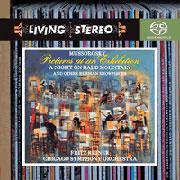How Good Are the RCA "Living Stereo" SACDs?
This famous 1957 “Living Stereo” three-track recording (originally LSC-2201, issued in 1958) was among the first series of bargain-priced BMG SACD's issued last year. A second set has recently been released. By focusing on the “audiophile community,” doubling up the content (two full LP's worth) and selling them for 12 bucks, BMG hit all the right notes, and apparently these are selling well-in the context of what that means in today's shrunken record biz.
Nonetheless, since BMG sent a set to a Stereophile writer for review, the in-house PR gal refused to send a set to me for review. I therefore relied upon my ol' pal Harry Pearson, founder of The Absolute Sound, who was kind enough to forward me his set for a few weeks' listening.
While a great deal of care has gone into these reissues, including good annotation, careful transfers using very fine equipment, something's not quite right. There was a consistent sound to all of the discs in the first series, and it was a sound I didn't particularly care for-a thickness and accentuation in the mid-bass that's not on the original, or on Classic's superb vinyl reissues at 33 1/3 and 45rpm. I also found the top end lacking in ultimate transparency and clarity.
The 45rpm set in particular is a major piece of sonic work, with a clarity, transparency and dynamic slam missing from the original and from this SACD. In fact, I actually prefer the lushness and legitimate bottom end weight and brass bite of JVC's XRCD2 (JMCXR-016)-a “redbook” CD-, though it costs far more, and doesn't include the second album's worth of Russian musical warhorses included in the less expensive SACD (see online dealers for full listings).
Still, it's difficult not to recommend these SACDs. The price is right, the sound pretty good, with the musical flow intact-something both vinyl and SACDs manage but standard CDs seem incapable of providing-and as an introduction to a legendary series, these can't be beat. The multi-channel layer includes the original 3 tracks spread across the front. Unless you have 3 identical full range speakers, stick with the 2 channel mixdown.
If you don't listen to classical music and want a pleasing entry, I can't think of a better one than this: Reiner's dramatic reading of “Pictures….” and the playing by the 1957 gathering of old white men-especially the strings-is stupendous. I saw a live performance by The New York Philharmonic last fall that couldn't touch this one from 1957.
The piece consists of a series of short compositions that do not require a strong structural musical knowledge to decipher. Originally written for piano and later orchestrated by Maurice Ravel, “Pictures at an Exhibition” is a melodic, impressionistic sonic spectacular that one rarely tires of hearing. A “warhorse” in the true sense of the word, and when you hear this rich, sensuous recording from way back when, you'll wonder whether the art of recording has made progress, spun in circles, or gone backwards since 1957. There's nothing “old” sounding about it. Ironically, an Acoustic Sounds customer wrote a review complaining about a “hollow sound,” and blaming it on the recording. It's not the recording. It's the mastering, which seems to have boosted the midbass. Do that, and by comparison the lower mids and mids will sound depressed by comparison, yielding a somewhat “hollow” sound. Still, a minor flaw considering the price. Of course if you have a turntable, get the Classic LP reissue.




